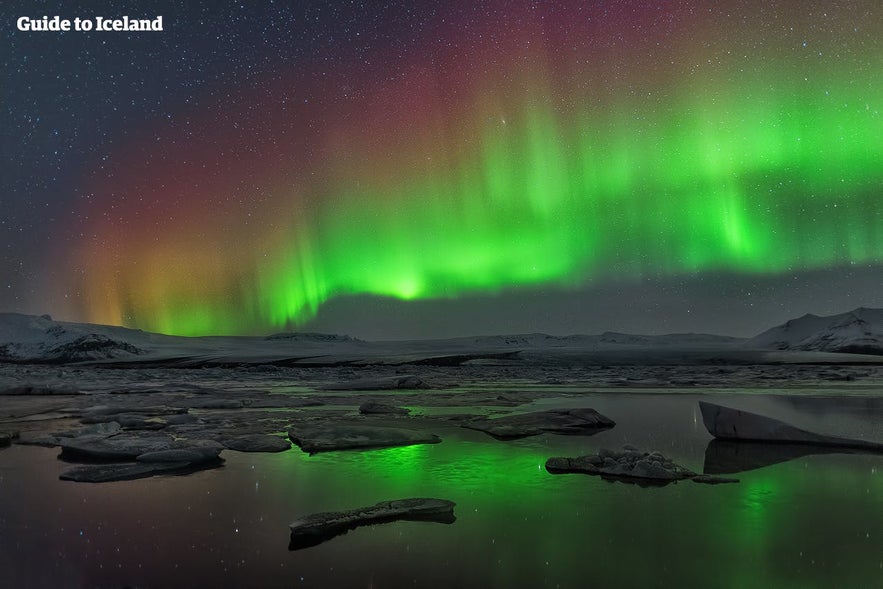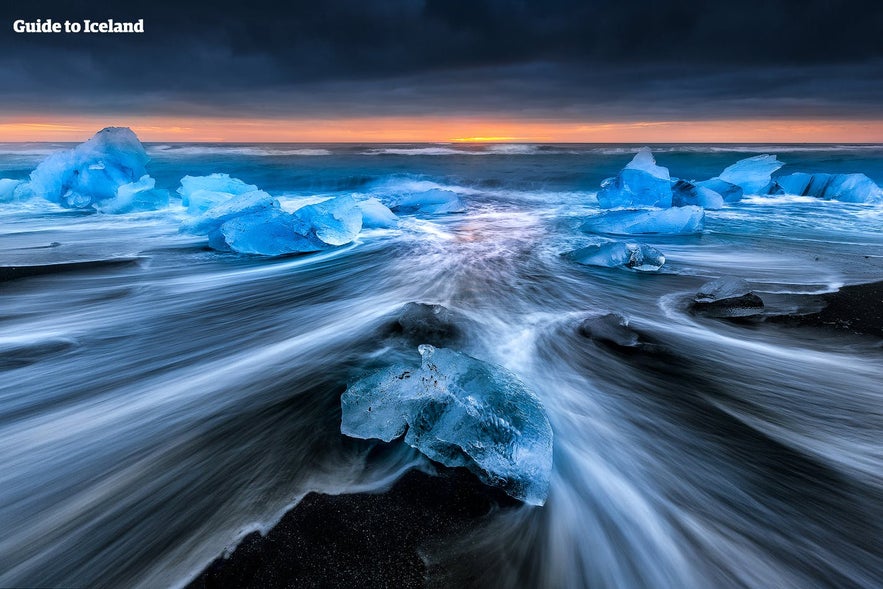
Glacier Lagoons in Iceland

Where can you find Iceland's glacier lagoons? What are the most stunning glacier lagoons in Iceland, and are there any hidden where you can avoid the crowds? Continue reading to learn all about this country’s magical glacier lagoons.
Iceland is a land of incredible, diverse sites, many of which are easy to access throughout the year. Visitors marvel over geysers, waterfalls, volcanoes, and lava landscapes, every feature as dramatic and beautiful as the last.
However, there is one natural feature found around Iceland that's incredibly unique and easy to visit: the glacier lagoons! These are formed by the flowing meltwater of Iceland's many glaciers, forming stunning lakes with floating icebergs.
The most famous of these lakes is located in South Iceland and can be visited on Jokulsarlon tours, which will take you up to the lake. You can also sail on the lagoon on a zodiac boat or even a kayak!
For those who want to stay close to a true natural wonder in the Icelandic wilderness, book a hotel at Jokulsarlon Lagoon for a short trip to see the floating icebergs. You can also drive there yourself if you rent a car in Iceland and set your aim for the south.
But what is a glacier lagoon? Glacier lagoons are lakes that form at the base of glaciers and are formed when the ice caps recede during the summer and erode a space in the earth where they once sat, which fills up with their meltwater. In Iceland, the first glacier lagoons began to form 10,000 years ago, at the end of the last ice age.
These lakes are notable for their coloration; as glacial ice is filled with sediment, they are often very murky, with the colors ranging from pale blues and greens to brown. Finding chunks of ice in them is very common, although few have bergs the size of those found at the most famous of the glacier lagoons, Jokulsarlon.
Despite its popularity, it is not Iceland’s only glacier lagoon. Eleven percent of this nation’s surface area is covered with ice, and wherever there is a glacial outlet, there is a good chance you will find a lake at its base. While some of these will be little more than murky pools, others bear a similar majesty to the iconic Jokulsarlon.
Jokulsarlon Glacier Lagoon
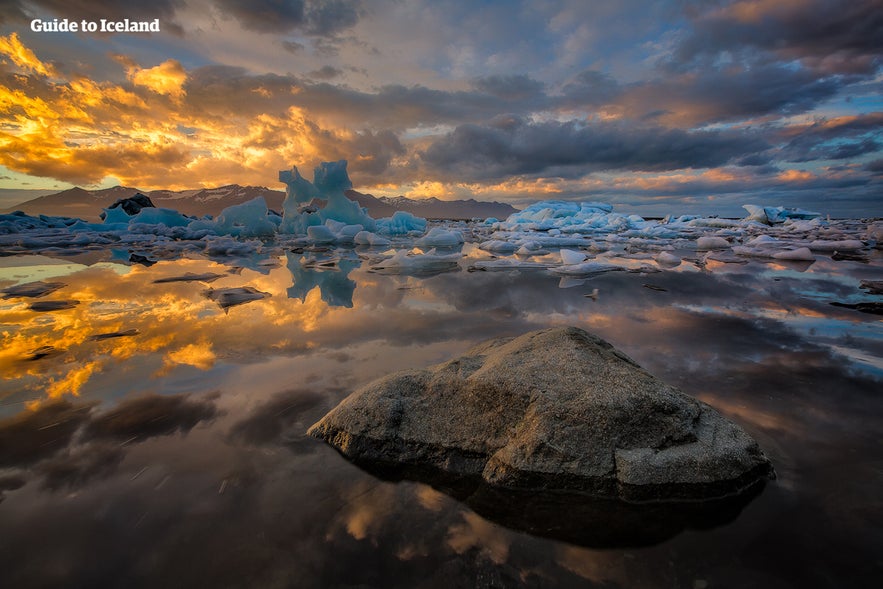 The most famous glacier lagoon in the country is Jokulsarlon, in Iceland’s south-east. This feature is a vast lake formed by the meltwater of Breidarmerkurjokull glacier, deeper than any other in Iceland and filled year-round with icebergs that calve from the outlet. Some of these tower stories are high, and the waters are home to many playful seals.
The most famous glacier lagoon in the country is Jokulsarlon, in Iceland’s south-east. This feature is a vast lake formed by the meltwater of Breidarmerkurjokull glacier, deeper than any other in Iceland and filled year-round with icebergs that calve from the outlet. Some of these tower stories are high, and the waters are home to many playful seals.
The best way to see the seals up close is on a zodiac boat tour, which takes you around the lake, allowing you to enjoy magnificent blue icebergs from a short distance. You can also go on an affordable glacier lagoon boat tour for a 35-minute go-around the lake, or explore it on an intimate kayak tour.
- See also: Seals and Seal Watching in Iceland
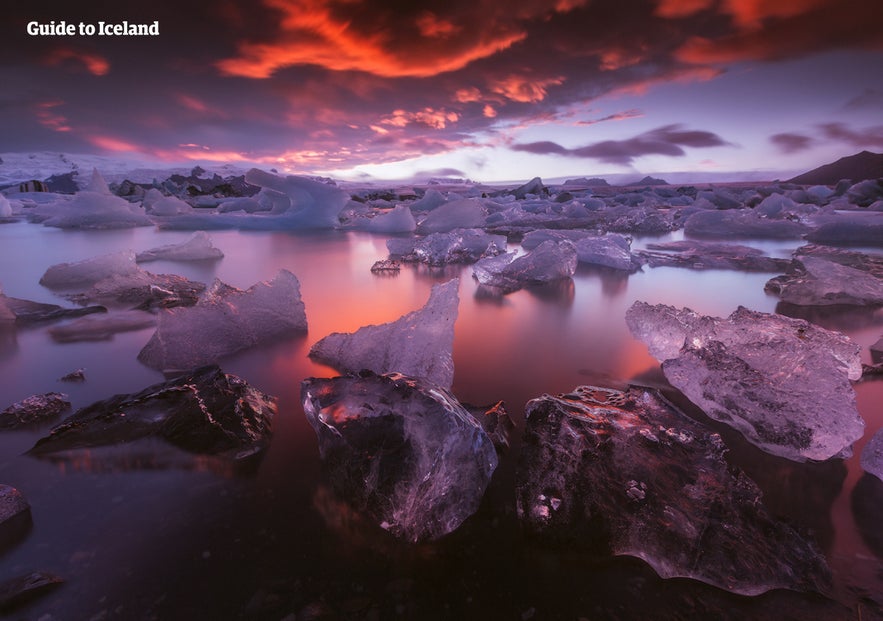 It is one of Iceland’s most photographed sites and draws visitors the world over. Those who come will find that even the most well-taken image, however, cannot compare to what awaits them here. It truly is one of the country’s—and the world’s—most mesmerizing places, where you can spend hours doing nothing but staring out in awe.
It is one of Iceland’s most photographed sites and draws visitors the world over. Those who come will find that even the most well-taken image, however, cannot compare to what awaits them here. It truly is one of the country’s—and the world’s—most mesmerizing places, where you can spend hours doing nothing but staring out in awe.
After exploring this incredible natural wonder, you can use the opportunity to step inside a glacier on the best ice cave tour from Jokulsarlon, which starts from the lagoon but takes you on top of a glacier in a monster truck and to the stunning Crystal Ice Cave, for an incredible opportunity to see sparkling blue ice cave.
Breidarlon Glacier Lagoon
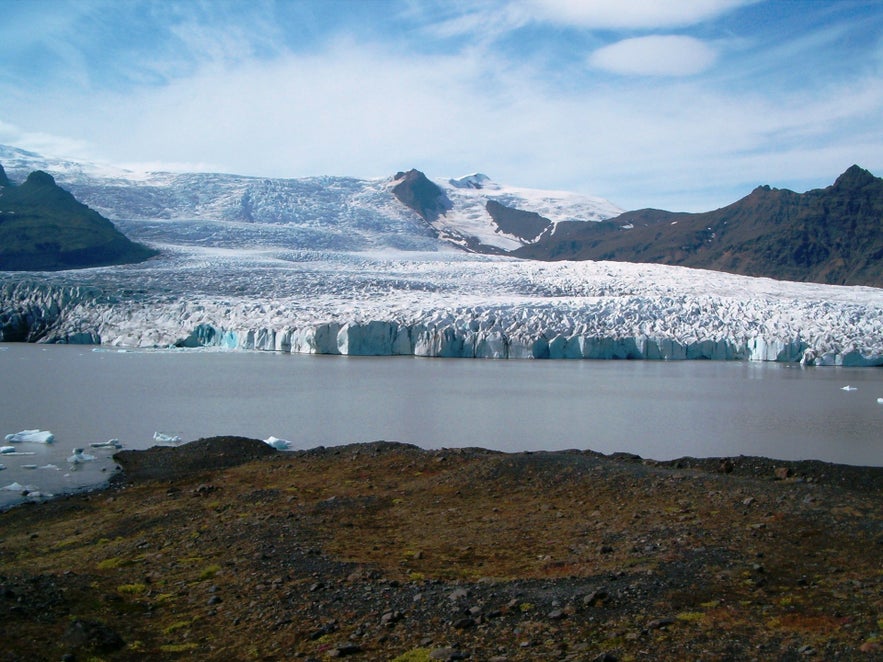
Hidden right beside Jokulsarlon, but far too often overlooked by visitors, is the Breidarlon glacier lagoon. Though not as vast as its famous neighbor, the hills that surround it grant much greater views of the surrounding area, particularly of Breidamerkurjokull.
In fact, from Breidarlon, it is easy to see how this glacier tongue is connected to the much vaster Vatnajokull glacier, the largest ice cap in Europe, which in itself covers eight percent of Iceland’s surface area. The scale of this feature is awe-inspiring but becomes even more impressive when witnessed as a backdrop to this beautiful lake.
You won’t find any seals in Breiðarlón, and the icebergs will not quite reach the scale of those in the adjacent lagoon, but the area is likely to be far less busy. This makes it an ideal spot for landscape photographers who want to capture the incredible, unique landscapes of Iceland without people ambling into their shots.
- See also: Photography in Iceland
Fjallsarlon Glacier Lagoon
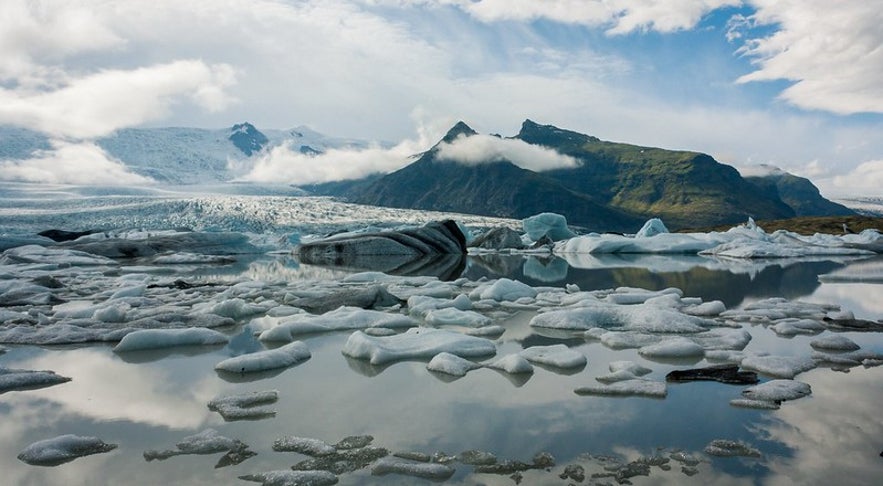 Photo by Mekanoide
Photo by Mekanoide
Connected to Breidarlon by a short river is another glacier lagoon that, in spite of its proximity to the major sites of the southeast, is also often forgotten. Fjallsarlon, however, is an incredible place to admire the glaciers in peace, and at the height of summer, you can find zodiac tours here that will allow you to explore it.
Even from shore, however, it is a fantastic site to marvel over. The lagoon boasts an incredible viewing point from Oraefajokull, a volcano that stands just to its side, which allows you to witness its scale and the surrounding area from above.
- See also: Volcanoes in Iceland
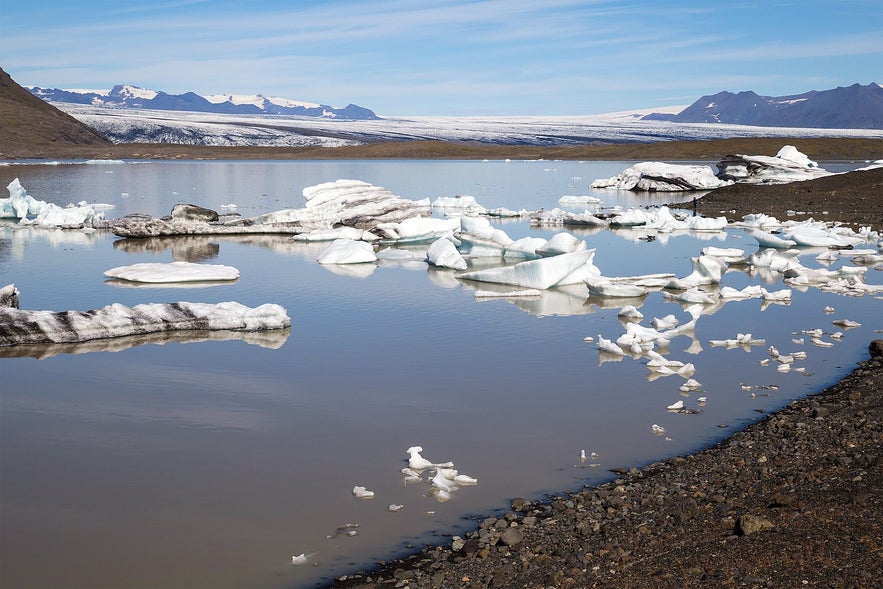
This volcano is a particularly interesting one, having erupted twice since settlement. The first eruption created the vast lava field in the Oraefasveit region, known as ‘the Wasteland’ in Icelandic, which contains many of the nearby sites of the area, such as the Skaftafell Nature Reserve.
Fjallsárlón is like Jokulsarlon in the sense that migratory seabirds, most notably the Skúa and Arctic Tern, nest on its shores throughout the summer months. At both locations, these birds should be admired with great caution; both species (particularly the latter) are notorious for the fierceness with which they defend their eggs and young.
This glacier lagoon was utilized in the Hollywood blockbuster film The Justice League, as Aquaman himself takes a dip in the water. Keep in mind that it's just a movie, and Aquaman is the god of the sea, so do not go in the water under any circumstances! Just admire it from afar.
Graenalon Glacier Lagoon
Graenalon is unique as a glacier lagoon in Iceland, as it is shrinking rather than expanding in spite of its origins in the retreating Vatnjokull. Once as large as Jokulsarlon is now, at seven square miles (18 square kilometers), it now just lingers around the edge of the ice at the Skeidararjokull glacial tongue, a fraction of its former self.
- See also: Lakes in Iceland
Even so, it fills with icebergs just like those listed above, which often wash up on the shore akin to those at the Diamond Beach, which sits adjacent to Jokulsarlon, making it a great destination for photographers.
It is also aesthetically very different from the lagoons listed above, as the water within is a murky green rather than an opaque azure, which is fitting as its name translates to "Green Lagoon". Furthermore, it is far from the coast, located northwest of Skaftafell, and surrounded on three sides by ice caps. The hiking trails around it are incredible for those who wish to immerse themselves in nature, far from any crowds.
Hvitarvatn Glacier Lagoon

Hvitarvatn is the largest and most beautiful glacier lagoon off of Langjökull, the second-largest glacier in Europe. Covering 11.5 square miles (30 square kilometers), it is up to 275 feet (84 meters) deep and is the sixth-largest lake in Iceland. It can be found in the Highlands and is accessible in summer in a four-wheel drive via the Kjolur Highland Route, or F35.
Hvitarvatn does not have as many icebergs as the other lagoons, and they are not quite as large, but it is a very common site to see small ones dotting its surface throughout the year. The lack of icebergs, however, means that on clear days, visitors have unobstructed views across the water to the beautiful, pristine glacier tongue that feeds into it.
Hvitarvatn is the source of the glacial river Hvita, which runs through south Iceland. This river is perhaps the most visited in the country due to the fact that it contains Gullfoss waterfall, one of the three points of the Golden Circle. In summer, it is also the most popular river for rafting due to its gentle rapids and dramatic surroundings. Unlike the Beast of the East, rafting on the Hvita river without experience, and is fun for the whole family.
Kaldalon Glacier Lagoon
Kaldalon is a very unique glacier lagoon, being the only one on this list located in the Westfjords. The singular glacier in this region is Drangajokull, alone amongst Iceland’s ice caps in the sense that it is the only one not retreating, due to its elevation and location in the country’s far north.
Drangajokull is rarely visited due to its remoteness and the fact that it is only easily accessible at the height of summer. Those who do manage to reach it, however, will often find themselves to be the only ones present, making it an ideal spot for photographers and nature lovers alike.
Kaldalon has become more of a fjord than a lagoon as it has expanded, connecting Drangajokull glacier to Isafjardardjup, the largest bay in the region. It occasionally is dotted with icebergs creeping their way out to the ocean. It is most easily reached by driving up Route 635.
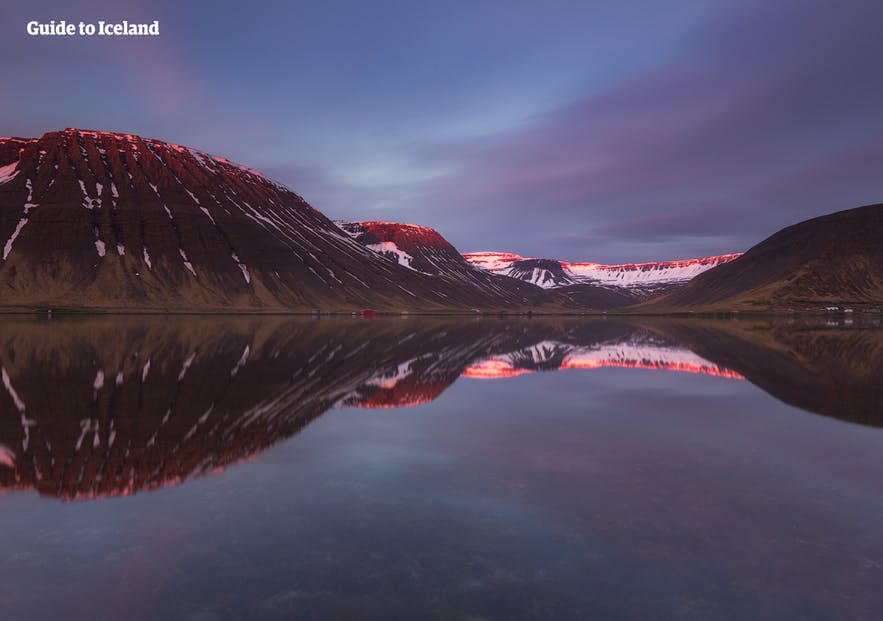
Those who visit should make the most of their time in this very remote part of Iceland, perhaps by visiting the nearby Hornstrandir Nature Reserve, the least populated region of the country. The flora and fauna here are unique and flourishing, making it a favorite destination for those passionate about wildlife.
- See also: The Westfjords of Iceland
Map of Glacier Lagoons in Iceland
To help aid your search for the lesser-known glacier lagoons, a map has been included below that contains the whereabouts of each lake listed above. Be aware that some can only be reached in summer if you plan to drive yourself, and even in these months. It is best to check the weather website and roads website to make sure that they are safely accessible.
Did you find our guide to Iceland's glacier lagoons helpful? Do you have any additional questions that this article didn't cover? Feel free to ask away, or leave your thoughts and comments in the box below!
더 많은 흥미로운 게시글
아이슬란드 토종말에 대한 모든 것
아이슬란드의 토종말이 특별한 이유는 무엇일까요? 아이슬란드 토종말과 다른 품종간의 차이점이 있다면 무엇일까요? 아이슬란드 어디에서 승마가 가능할까요? ‘아이슬란드 토종말’은 실제 보면 ‘아이슬란드 조랑말’이라면서요? 이런 질문이 있으시다면 아래 글을 읽어봐 주세요. 아이슬란드 초기 정착 시대부터 현재까지 아이슬란드 말의 역사, 중요성 그리고 현재의 모습...더 보기
아이슬란드 얼음 동굴 완벽 가이드
아이슬란드의 얼음 동굴에 대한 모든 정보를 한눈에 확인하세요. 최고의 얼음 동굴은 어디에 있을까요? 방문하려면 어떻게 해야 할까요? 그리고 얼음 동굴과 빙하 동굴은 무엇이 다를까요? 아이슬란드의 신비로운 얼음 동굴을 낱낱이 소개합니다! 아이슬란드를 방문하는 많은 여행자에게 얼음 동굴 탐험은 꿈 같은 모험입니다. 광활한 빙하 속에서 자연적으로 형성된 이...더 보기아이슬란드의 백야 완벽 가이드
여름철 백야 기간 동안 아이슬란드에서 일출과 일몰은 얼마나 오래 지속되는지, 어느 달에 백야 현상이 발생하는지 등 아이슬란드의 백야에 대해 궁금한 모든 것을 정리해 보았습니다. 백야로 인해 밤에도 밖이 환할 때 잠을 청하는 방법 등 유용한 정보까지 포함된 아이슬란드 백야 완벽 가이드입니다. 아이슬란드에서는 해가 지지 않아 낮이 24시간 지속된다는 이야기...더 보기

아이슬란드 최대의 여행 마켓플레이스를 전화에 다운로드하여 전체 여행을 한 곳에서 관리하세요
전화 카메라로 이 QR 코드를 스캔하고 표시되는 링크를 누르면 아이슬란드 최대의 여행 마켓플레이스를 주머니에 넣을 수 있답니다. 다운로드 링크가 포함된 SMS 또는 이메일을 받으려면 전화번호 또는 이메일 주소를 추가하세요.
